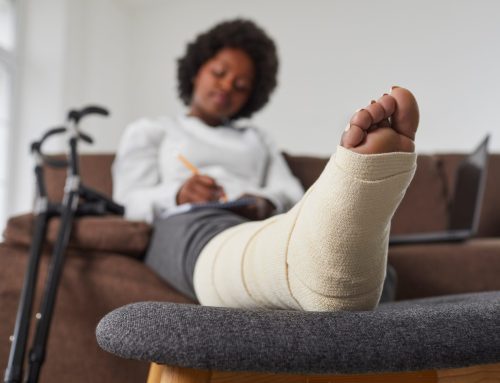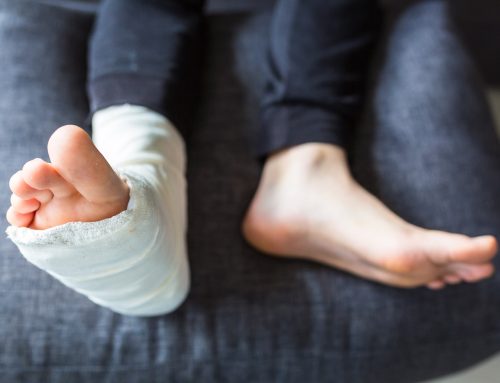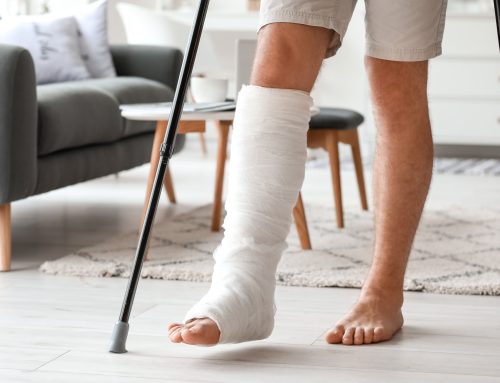Breaking a collarbone is no laughing matter. It’s incredibly painful and can take several months to fully heal. One of the biggest challenges during this recovery period is getting a good night’s sleep.
Sleeping with a broken collarbone, also known as a clavicle fracture, can be tough due to the discomfort and limited mobility it causes. However, with the right strategies and adjustments, you can improve your sleep quality and support your body’s healing process.

So, what is the best way to sleep with a broken collarbone? Let’s explore effective tips for sleeping comfortably with a broken collarbone and discuss how innovative treatments like Low-Intensity Pulsed Ultrasound (LIPUS) therapy can work to accelerate your recovery.
Understanding Clavicle Fractures
A broken collarbone, or clavicle fracture, occurs when the clavicle bone cracks or breaks due to trauma or impact. This type of injury is quite common and can happen to anyone, but certain factors increase the risk:
- Active Individuals and Athletes: People who participate in contact sports like hockey, football, or martial arts are more susceptible due to the high likelihood of falls and collisions.
- Children and Teenagers: Since their bones are still growing, children and adolescents are more prone to fractures from impacts.
- Older Adults: Bone density decreases with age, making seniors more vulnerable to fractures even from minor falls.
For a comprehensive look at clavicle fractures, including detailed causes, risk factors, and treatment options, please visit our article: Clavicle Fracture Treatment and Healing.
Challenges of Sleeping with a Broken Collarbone
Sleeping with a broken collarbone presents several challenges that can make restful sleep seem elusive. Understanding these obstacles is the first step toward finding effective solutions to improve your sleep quality during recovery.
- Persistent Pain and Discomfort
- Movement-Induced Pain: Even slight movements during sleep can cause sharp pain in the shoulder and collarbone area.
- Difficulty Finding a Comfortable Position: Traditional sleeping positions may put pressure on the injured area, increasing discomfort.
- Nighttime Throbbing: Pain may intensify at night due to reduced distractions and the body’s heightened awareness of discomfort.
- Limited Mobility
- Use of Immobilization Devices: Wearing a sling or brace restricts arm movement, making it challenging to adjust positions while sleeping.
- Inability to Lie on the Affected Side: Lying on the injured side is usually too painful, limiting your sleeping positions to your back or the uninjured side.
- Sleep Disruptions
- Frequent Awakenings: Pain flare-ups can cause you to wake up multiple times during the night.
- Difficulty Falling Asleep: Anxiety about causing more pain or re-injuring the collarbone may make it hard to relax and drift off.
- Reduced Sleep Quality: Interrupted sleep can leave you feeling unrefreshed, impacting your overall healing process.
- Psychological Factors
- Anxiety and Stress: Worrying about your injury and recovery can contribute to insomnia or restless sleep.
- Frustration: The inability to sleep comfortably may lead to irritability and decreased morale, which can affect healing.
- Impact on Daily Functioning
- Daytime Fatigue: Poor sleep can result in daytime drowsiness, affecting your ability to perform daily tasks and follow your treatment plan.
- Slower Healing Process: Lack of quality sleep can impede the body’s natural healing mechanisms, potentially prolonging recovery time.
Getting a Good Night’s Sleep With a Clavicle Fracture
Sleeping with a broken collarbone can be challenging, but implementing certain strategies can significantly improve your comfort and sleep quality. Here are some effective tips to help you rest better during your recovery:
- Use Extra Pillows
- Elevate Your Upper Body: Sleeping in a slightly upright position reduces pressure on the clavicle. Use pillows or a wedge pillow to prop yourself up.
- Support Your Arm: Place a pillow under the injured arm to keep it elevated and stable, which can help reduce pain and swelling.
- Prevent Rolling Over: Surround yourself with pillows to maintain your position and prevent accidental movements during sleep.
- Take Pain Medication as Directed
- Follow Medical Advice: Use prescribed medications or over-the-counter pain relievers like acetaminophen or ibuprofen.
- Timing Is Key: Take pain medication about 30 minutes before bedtime to allow it to take effect.
- Avoid Overmedication: Stick to the recommended dosage and avoid mixing medications without consulting your doctor.
- Apply Ice Before Bed
- Reduce Inflammation: Applying an ice pack can numb the area and decrease swelling.
- How to Apply: Wrap ice in a cloth to prevent skin damage and place it on the fracture site for 15–20 minutes before sleep.
- Consistency Helps: Ice the area several times a day, especially before bedtime, and during the first few days after the injury.
- Create a Relaxing Sleep Environment
- Maintain a Comfortable Room Temperature: A cool, dark, and quiet environment promotes better sleep.
- Establish a Bedtime Routine: Consistent sleep schedules help regulate your body’s internal clock.
- Limit Screen Time Before Bed: Avoid using electronic devices at least an hour before bedtime to improve sleep quality.
- Practice Relaxation Techniques: Deep breathing exercises or meditation can help reduce stress and ease you into sleep.
By implementing these strategies, you can enhance your comfort and improve your sleep quality, which is essential for healing your broken collarbone. Remember, quality sleep contributes to tissue repair and boosts your immune system, contributing to a smoother and potentially faster recovery.
Can I sleep without a sling with a broken collarbone?
One common question we get is, “Can I sleep without a sling with a broken collarbone?”
Take breaks from your sling. Often, doctors will prescribe the use of a sling on the attached arm after a clavicle break. By minimizing movement of the collarbone, it allows the bone to heal and pain to be reduced. The sling should be worn throughout the day but can be taken off at night or when bathing. But you may need to experiment, as some people find wearing a sling while sleeping more comfortable.
- Experiment for Comfort: Pay attention to how your shoulder feels when sleeping without the sling. If you experience increased pain or discomfort, consider wearing it loosely for support.
- Consult Your Doctor: Before making changes to how you use your sling, discuss it with your healthcare provider to ensure it won’t hinder your healing process.
Accelerating Healing of a Broken Collarbone
Recovering from a broken collarbone requires patience and adherence to your doctor’s recommendations. While the body has an incredible ability to heal itself, there are ways you can support the healing process:
Importance of Rest and Sleep
- Facilitates Healing: Adequate rest allows your body to direct energy toward repairing the fractured bone.
- Reduces Stress on the Injury: Limiting movement prevents additional strain on the clavicle, aiding in proper alignment and healing.
- Enhances Sleep Quality: Quality sleep is essential for tissue regeneration and overall recovery.
Tips for Better Sleep:
✓ Follow Medical Advice: Stick to your doctor’s guidelines regarding activity levels and rest periods.
✓ Create a Restful Environment: Ensure your sleeping area is comfortable and free from distractions to promote better sleep.
✓ Listen to Your Body: If you experience increased pain or discomfort, it’s a signal to take it easy.
Role of Nutrition and Hydration
- Bone-Healing Nutrients:
- Calcium: Essential for bone strength; found in dairy products, leafy greens, and fortified foods.
- Vitamin D: Helps the body absorb calcium; obtained from sunlight exposure, fatty fish, and fortified foods.
- Protein: Supports tissue repair; include lean meats, beans, nuts, and seeds in your diet.
- Hydration: Drinking enough water aids in nutrient transport and helps maintain overall health.
Tips for Nutrition:
✓ Balanced Diet: Incorporate a variety of nutrient-rich foods to support bone healing.
✓ Consult a Professional: Speak with a nutritionist or your doctor about dietary supplements if you have specific dietary restrictions.
Avoiding Strenuous Activities
- Prevent Re-injury: Engaging in heavy lifting or high-impact exercises can hinder healing or cause further damage.
- Adhere to Activity Restrictions: Your doctor may recommend limiting certain movements to promote proper healing.
Tips for Movement:
✓ Gradual Rehabilitation: As you heal, slowly reintroduce activities under the guidance of a healthcare professional.
✓ Physical Therapy: Consider working with a physical therapist to regain strength and mobility safely.
Innovative Treatments: LIPUS Therapy
In addition to traditional healing methods, innovative treatments like Low-Intensity Pulsed Ultrasound (LIPUS) therapy may offer additional support in your recovery process.
What Is LIPUS?
LIPUS is a non-invasive therapy that uses low-intensity sound waves to stimulate bone healing at the cellular level. Applied directly over the fracture site with a specialized device, LIPUS delivers painless, pulsed ultrasound waves that penetrate soft tissue to reach the bone.
Benefits of LIPUS for a Broken Collarbone:
- Non-Invasive Treatment: No surgery or injections are required, reducing the risks associated with invasive procedures.
- Convenient: Treatments are typically around 20 minutes per day and can be performed at home.
- Faster Healing: Studies suggest that LIPUS may reduce healing time for certain types of fractures, helping you return to normal activities sooner.
Recovering from a broken collarbone can be challenging, but taking proactive steps can support your body’s natural healing process. Prioritizing rest, maintaining a nutritious diet, and avoiding strenuous activities are fundamental to promoting recovery.
Additionally, exploring innovative therapies like LIPUS may offer additional benefits in accelerating the healing of your clavicle fracture. A good sleep alone is often not enough for healing a broken bone, but there are innovations in quickening the process.
Meghan, a fitness instructor, broke her clavicle at the age of 43. She was told by two different doctors that she needed surgery to heal the fracture but she didn’t want to go that route. “Don’t be afraid to look at alternatives,” said Meghan. After doing her own research and discussing her options with a colleague, she was referred to Inline Medical Inc. for low-intensity pulsed ultrasound (LIPUS) therapy.
Interested in learning more about how LIPUS therapy can aid in healing your broken collarbone? Contact Fracture Healing today to discuss your options and take a proactive step toward a faster recovery.





